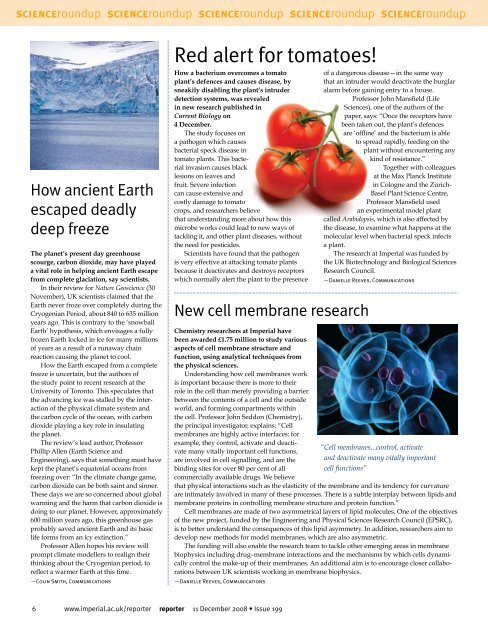199 as pdf - Imperial College London
199 as pdf - Imperial College London
199 as pdf - Imperial College London
You also want an ePaper? Increase the reach of your titles
YUMPU automatically turns print PDFs into web optimized ePapers that Google loves.
scienceroundup scienceroundup scienceroundup scienceroundup scienceroundup<br />
How ancient Earth<br />
escaped deadly<br />
deep freeze<br />
The planet’s present day greenhouse<br />
scourge, carbon dioxide, may have played<br />
a vital role in helping ancient Earth escape<br />
from complete glaciation, say scientists.<br />
In their review for Nature Geoscience (30<br />
November), UK scientists claimed that the<br />
Earth never froze over completely during the<br />
Cryogenian Period, about 840 to 635 million<br />
years ago. This is contrary to the ‘snowball<br />
Earth’ hypothesis, which envisages a fully<br />
frozen Earth locked in ice for many millions<br />
of years <strong>as</strong> a result of a runaway chain<br />
reaction causing the planet to cool.<br />
How the Earth escaped from a complete<br />
freeze is uncertain, but the authors of<br />
the study point to recent research at the<br />
University of Toronto. This speculates that<br />
the advancing ice w<strong>as</strong> stalled by the interaction<br />
of the physical climate system and<br />
the carbon cycle of the ocean, with carbon<br />
dioxide playing a key role in insulating<br />
the planet.<br />
The review’s lead author, Professor<br />
Phillip Allen (Earth Science and<br />
Engineering), says that something must have<br />
kept the planet’s equatorial oceans from<br />
freezing over: “In the climate change game,<br />
carbon dioxide can be both saint and sinner.<br />
These days we are so concerned about global<br />
warming and the harm that carbon dioxide is<br />
doing to our planet. However, approximately<br />
600 million years ago, this greenhouse g<strong>as</strong><br />
probably saved ancient Earth and its b<strong>as</strong>ic<br />
life forms from an icy extinction.”<br />
Professor Allen hopes his review will<br />
prompt climate modellers to realign their<br />
thinking about the Cryogenian period, to<br />
reflect a warmer Earth at this time.<br />
—Colin Smith, Communications<br />
Red alert for tomatoes!<br />
How a bacterium overcomes a tomato<br />
plant’s defences and causes dise<strong>as</strong>e, by<br />
sneakily disabling the plant’s intruder<br />
detection systems, w<strong>as</strong> revealed<br />
in new research published in<br />
Current Biology on<br />
4 December.<br />
The study focuses on<br />
a pathogen which causes<br />
bacterial speck dise<strong>as</strong>e in<br />
tomato plants. This bacterial<br />
inv<strong>as</strong>ion causes black<br />
lesions on leaves and<br />
fruit. Severe infection<br />
can cause extensive and<br />
costly damage to tomato<br />
crops, and researchers believe<br />
that understanding more about how this<br />
microbe works could lead to new ways of<br />
tackling it, and other plant dise<strong>as</strong>es, without<br />
the need for pesticides.<br />
Scientists have found that the pathogen<br />
is very effective at attacking tomato plants<br />
because it deactivates and destroys receptors<br />
which normally alert the plant to the presence<br />
New cell membrane research<br />
Chemistry researchers at <strong>Imperial</strong> have<br />
been awarded £1.75 million to study various<br />
<strong>as</strong>pects of cell membrane structure and<br />
function, using analytical techniques from<br />
the physical sciences.<br />
Understanding how cell membranes work<br />
is important because there is more to their<br />
role in the cell than merely providing a barrier<br />
between the contents of a cell and the outside<br />
world, and forming compartments within<br />
the cell. Professor John Seddon (Chemistry),<br />
the principal investigator, explains: “Cell<br />
membranes are highly active interfaces: for<br />
example, they control, activate and deactivate<br />
many vitally important cell functions,<br />
are involved in cell signalling, and are the<br />
binding sites for over 80 per cent of all<br />
commercially available drugs. We believe<br />
of a dangerous dise<strong>as</strong>e—in the same way<br />
that an intruder would deactivate the burglar<br />
alarm before gaining entry to a house.<br />
Professor John Mansfield (Life<br />
Sciences), one of the authors of the<br />
paper, says: “Once the receptors have<br />
been taken out, the plant’s defences<br />
are ‘offline’ and the bacterium is able<br />
to spread rapidly, feeding on the<br />
plant without encountering any<br />
kind of resistance.”<br />
Together with colleagues<br />
at the Max Planck Institute<br />
in Cologne and the Zurich-<br />
B<strong>as</strong>el Plant Science Centre,<br />
Professor Mansfield used<br />
an experimental model plant<br />
called Arabidopsis, which is also affected by<br />
the dise<strong>as</strong>e, to examine what happens at the<br />
molecular level when bacterial speck infects<br />
a plant.<br />
The research at <strong>Imperial</strong> w<strong>as</strong> funded by<br />
the UK Biotechnology and Biological Sciences<br />
Research Council.<br />
—Danielle Reeves, Communications<br />
“Cell membranes...control, activate<br />
and deactivate many vitally important<br />
cell functions”<br />
that physical interactions such <strong>as</strong> the el<strong>as</strong>ticity of the membrane and its tendency for curvature<br />
are intimately involved in many of these processes. There is a subtle interplay between lipids and<br />
membrane proteins in controlling membrane structure and protein function.”<br />
Cell membranes are made of two <strong>as</strong>ymmetrical layers of lipid molecules. One of the objectives<br />
of the new project, funded by the Engineering and Physical Sciences Research Council (EPSRC),<br />
is to better understand the consequences of this lipid <strong>as</strong>ymmetry. In addition, researchers aim to<br />
develop new methods for model membranes, which are also <strong>as</strong>ymmetric.<br />
The funding will also enable the research team to tackle other emerging are<strong>as</strong> in membrane<br />
biophysics including drug–membrane interactions and the mechanisms by which cells dynamically<br />
control the make-up of their membranes. An additional aim is to encourage closer collaborations<br />
between UK scientists working in membrane biophysics.<br />
—Danielle Reeves, Communications<br />
6 www.imperial.ac.uk/reporter reporter 11 December 2008 • Issue <strong>199</strong>

















